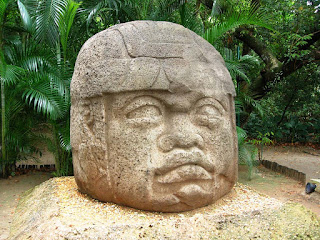The La Venta Museum in Villahermosa, Mexico, has an intriguing collection of Olmec sculptures, including three colossal Olmec stone heads. The artifacts had been moved there from the Olmec settlement of La Venta in western Tabasco, when petroleum exploration in the 1950s had threatened the safety of these rare objects.
Posts by "Stones and Megaliths"
Showing posts with label Stones and Megaliths. Show all posts
The La Venta Museum in Villahermosa, Mexico, has an intriguing collection of Olmec sculptures, including three colossal Olmec stone heads. The artifacts had been moved there from the Olmec settlement of La Venta in western Tabasco, when petroleum exploration in the 1950s had threatened the safety of these rare objects.
The Nartiang Monoliths is one of the most fascinating megalithic sites in India. Located in the Jaintia hills of Meghalaya, roughly 60 kms from the state capital of Shillong, it has the largest concentration of monoliths at one place in the state.
The locals refer to the place as "Kper Mawbynna", which means "Monolith Garden". As per Jaintia legends, the biggest monolith in the site was raised by a "giant" man named U Mar Phalyngki, a trusted lieutenant of a Jaintia king, to commemorate his victory in battle. The other monoliths were erected by U Mar Phalyngki, U Luh Lyngshkor Lamare and various clans of the Nartiang village between 1500 - 1835 AD.
The Jaintia kings ruled in these parts from 1500 - 1835 AD, with their capital in Jaintiapur, in the plains of Bangladesh at the foot of the Jaintia hills. Nartiang was, apparently, a summer capital of the Jaintia kings. As I roamed around in the monolith garden, I was struck with wonder at this large collection of megalithic monuments. Some of the stones were gigantic, and I wondered how such large stones were transported to the hilltop, and what made the ancient inhabitants of this place expend so much time and effort for erecting these formations. I will share my observations as we go through the photo journey.
There are many "sacred groves" in the Khasi and Jaintia hills of Meghalaya. The people believe that a forest deity called "Labasa" resides in these sacred groves and protects the village and community, and provides for their well-being. One should not take anything out from the grove - be it a fruit, flower or a twig - or leave anything behind (even spit). Else, the forest deity will get offended and unfortunate things will happen to the person.
We visited the Mawphlang sacred forest in the East Khasi Hills, roughly 25 kms from Shillong. The term Mawphlang means "moss-covered stones" - probably a reference to the large number of moss-covered monoliths in the forest. Our guide was very interactive, and explained to us the medicinal properties of many plants and trees growing in the forest. These sacred groves have rich biodiversity, and a large number of endemic and rare plant species can be found here.
There are different types of monoliths in the forest. Our guide said that they are "memorial pillars for clan ancestors", without providing additional details. Monolith building is no longer a living tradition amongst the Khasi tribals, since most of them converted to Christianity over the past 100 years or so. The best sources of information about these ancient stones that dot the hillsides and groves of Mehgalaya are the exploratory surveys done in the late 19th and early 20th centuries, when monolith building used to be a custom.
Subscribe to:
Posts (Atom)




